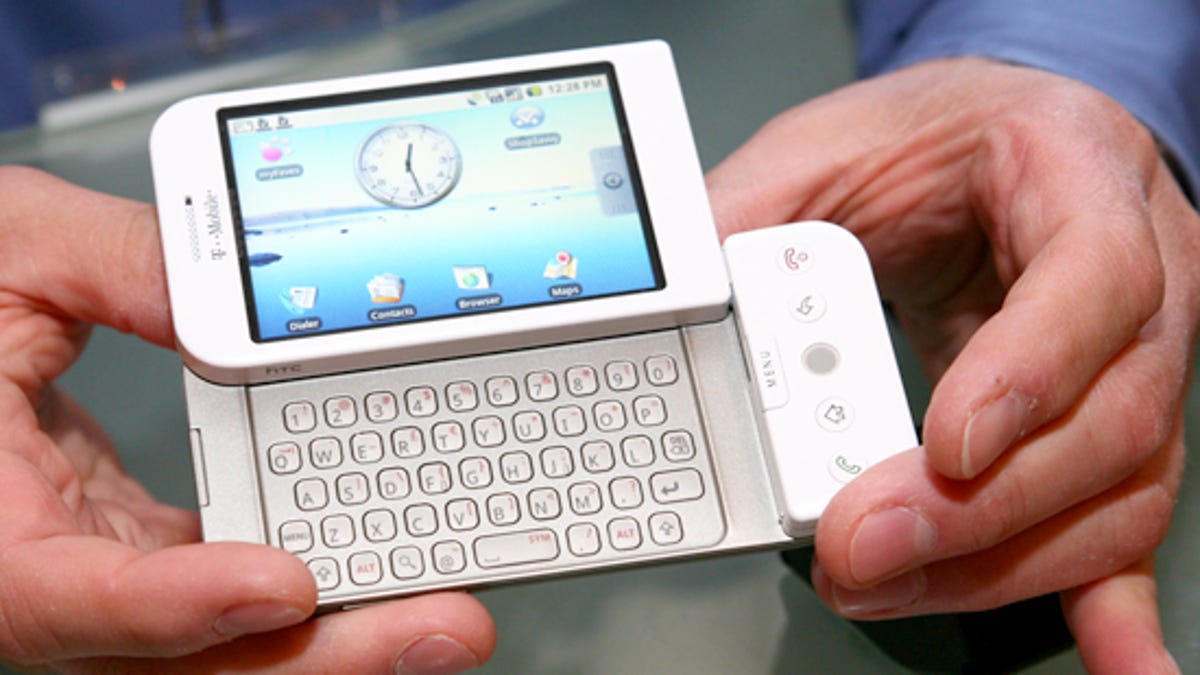For Google's Android phone, it's what's inside that counts
The new T-Mobile G1 may be no beauty, but its software creates a mobile Web surfing experience that beats much of the competition.

NEW YORK--Google's first Android phone may not win any beauty contests, but the smartphone's software and advanced Web browsing will give today's current crop of smartphones, including the iPhone, a run for their money.
T-Mobile USA and Google unveiled the first Google Android phone Tuesday at an event here. The phone, previously code-named the HTC Dream, is now called the T-Mobile G1. And it goes on sale in the U.S. on T-Mobile's network starting October 22 for $179 with a two-year service contract.
T-Mobile USA's parent company Deutsche Telekom will also be selling the device starting in November in the United Kingdom through its T-Mobile service. And the phone will be available throughout the rest of Europe via T-Mobile starting in the first quarter of 2009.
From a hardware perspective, the G1 isn't a game changer. The device, which has a full QWERTY keyboard that slides out from a touch-screen exterior, looks similar to acknowledged openly during the launch event.
Still, T-Mobile executives and Google's top mobile executives, Andy Rubin and Rich Miner, said that because the operating system is open, third-party developers could easily create an application to hook into corporate e-mail. And eventually, G1 users could download the application from the Android Market on their devices.
Not surprisingly, Scott Rockfeld, group product manager for Windows Mobile at Microsoft, sees the lack of corporate applications as a key weakness in the new device.
"Our strategy is to provide one phone for your life," he said. "And that's not what Google is delivering with this phone. They don't support many of the business applications that users have come to expect in the business space. It's an entire area they completely ignored."
But when it comes to Web surfing, Google has created a user experience superior to what's offered on most other smartphones today. And for T-Mobile this was critical as the company was looking for a smartphone to appeal to consumers looking for a robust mobile Web experience.
"Not everyone who is interested in having a smartphone wants to check e-mail all the time," said Leslie Grandy, vice president of product development for T-Mobile USA. "The G1 is about bringing the Web experience onto a phone and letting people do things with their phone they couldn't do before."
Indeed, the G1 offers an experience that is hard to match on other smartphones. Google applications, such as Gmail and Google Search have been tightly integrated into the phone's directory, making it easy and intuitive to quickly send e-mails or forward Web links to contacts. The G1 also has embedded GPS capability that allows users to get Google Maps Street View on their phones. An internal compass even allows users to navigate and see where they're going by moving the phone in different directions.
But when it comes to actually making an impact on the market in terms of sales, T-Mobile and Google will have their work cut out for them. Without corporate e-mail support, it's unlikely the phone will take a significant market share away from the market leaders in the U.S., RIM and Windows Mobile--at least in the near term.
Keeping up with the iPhone
The G1 also has to play catch-up to Apple's iPhone, which during the second quarter of 2008 accounted for about 9 percent of all smartphones shipped, according to Gartner. While the iPhone may not dominate the market in terms of sales, it is gaining momentum. Many analysts predict that Apple will hit, if not exceed, its goal of shipping 10 million iPhones by the end of 2008.
One of the biggest hurdles for G1 in competing with these other phones is the fact that T-Mobile's total network footprint is considerably smaller than footprints of other major carriers. For this reason, some iPhone users, who subscribe to AT&T's network, or some Windows Mobile users subscribing to Sprint Nextel or Verizon Wireless, may not be able to get adequate coverage from T-Mobile.
Still, T-Mobile is available in most major metropolitan areas. And the company is currently expanding its 3G network and will have 22 markets with 3G when the G1 launches and 27 markets up and running with 3G by the end of the year, Brodman said during Tuesday's press event. At that time nearly 80 percent of T-Mobile's subscribers will have access to its 3G network.
If coverage isn't an issue for consumers, then the G1 could make for a compelling competitor to the iPhone, especially with T-Mobile's aggressive pricing structure. The G1, which will sell for $179 with a two-year contract, offers subscribers the choice of two service plans. Each plan requires users to also subscribe to a voice plan. With the most basic voice plan that costs about $35 a month, users can get unlimited Web surfing and 400 text messages for $25 extra a month for a total price tag of about $60 a month. For $35 extra, subscribers can get unlimited Web and unlimited texting, bringing the total cost to $70 per month.
This is a deal considering that AT&T's iPhone plan, starts at $70 for voice service, unlimited Web usage, and no messaging. If subscribers want texting they can choose from a number of plans that cost extra or get an unlimited texting plan for $20 more a month. In total, a similar service plan that costs G1 users $70 a month on T-Mobile will likely run AT&T iPhone users about $90 a month.
For now, we'll just have to wait and see how the G1 fares. But as the only Google Android phone on the market, it may see a quick uptick in sales simply out of curiosity.
Click here for full coverage of Google Android.

